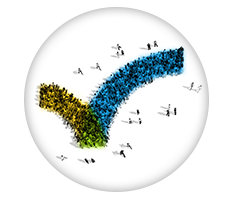The Marketer’s Guide to Customer Data Platforms (CDPs)

Customer Data Platforms (CDPs) are gaining popularity with marketing teams. But what are they? Why are people using them? How are they different than what you already have in your MarTech stack?
We hosted Katie Linford, Principal Analyst at Forrester, as a special guest on our Future of MarTech webinar, and some of her thoughts are included below.
What a CDP is
A CDP is a platform that centralizes customer data from multiple sources and makes it available to systems of insight and engagement. It can pull from all of your data sources to create one repository for marketing teams to use. However, it’s different than a typical database because it also offers functionality that can provide insights into your data. A CDP can build and segment audiences, provide reports, and even suggest the next best action for a prospect.
How to use a CDP
For the most part, customer data platforms provide functionality in two main areas.
- Data hygiene. CDPs can augment, unify, clean, and dedupe first- and third-party data, and create a persistent store for marketing of this account, contact, and buying group profiles.
- Advanced analytics. As we mentioned above, CDPs aren’t just showing you data, they’re drawing insights from that data. If your team has a goal to become more data driven, this feature is a huge selling point for a CDP.
There are two sub-categories of advanced analytics worth calling out.
Audience segmentation. This is especially true for B2B specialists. If you know your audience criteria, your CDP can sort your data into the segments you need.
Lead scoring. The CDP already looks at all of your leads, combines duplicate records, and makes recommendations about how to interact with them. Lead scoring is the next logical step. Let your CDP tell you how engaged your leads are and when they’re ready to be passed to your sales team.
Overall, using a CDP is a reduction of the manual process. If you’ve ever tried to dedupe something manually on Excel, you know how easy it is to make a mistake. CDPs can do all of that work for you, and because it’s a technology, the risk of error is much lower. This also gives you more time to engage with your customers instead of manually sorting through their information.
“ABM platforms are one of the biggest marketing technologies where we’re seeing CDP functionality offered because they rely entirely on data to move forward with the tactics they provide.”
- Katie Linford, Principal Analyst, Forrester, The Future of MarTech
What a CDP isn’t
A CDP is not a customer relationship management tool (CRM), sales force automation tool (SFA) or data lake – and it’s not designed to replace those things, either. It does, however, work in conjunction with them.
CDPs vs. Data Providers
CDPs are tools that you'll use to work with data.
Data providers help augment your existing data and provide the data that you're missing.
But the two aren’t mutually exclusive; some data providers offer CDPs. And that makes sense. We want to get data, we want to get it into our system, and we want to work with it. It’s even better if you can go to one place and get all of those things together (i.e. both a data provider and a CDP).
What you need before you use a CDP
If you’d like to use a customer data platform, there are a few things to consider.
First, you need to look at your data. Start with your data strategy, specifically. What data do you need? And how do you plan to use it? Once you have those questions answered, it will make the rest a lot simpler.
Next, think about who is going to run it day-to-day. Keep in mind that there's no right or wrong answer here. Maybe it's your strategic marketing team; maybe it’s your data science team. The CDPs in market have varied levels of marketing-friendliness for things like audience segmentation and reporting. Make sure you select a CDP that best aligns to the skillset and the capacity of your teams who will be working in it regularly.
You also need to make sure your CDP will connect with your tech stack – especially your CRM. This piece is critical. CDPs provide integration points to many of the products in your ecosystem, but not every CDP connects to every technology. So when you’re doing your research, make sure the CDPs you’re considering connect to the tools that you have. These integration points should be a major factor in your choice of a CDP.
Next Steps
As you review your data, your data strategy, and what you need in a CDP, Anteriad is here to help. Explore our data solutions to see how we can help you get ready to use a CDP.
“We really should know the customer. We really do need good customer data. We cannot market the way we want and reach the customers the we want to without it. So, we are seeing an increase in things like CDPs, like data providers – tools like that to really help marketing get to a place where they can get real-time access to the customer data they need.”
- Katie Linford, Principal Analyst, Forrester, The Future of MarTech

